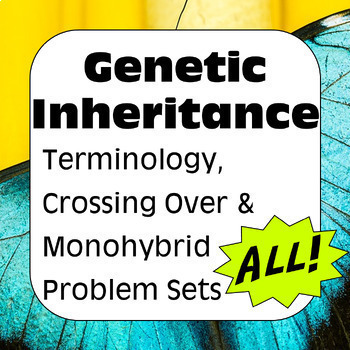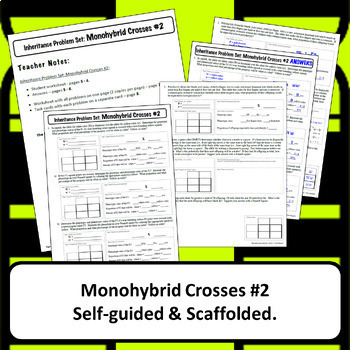Genetic Inheritance: Terminology, Crossing-Over, & Mendelian Monohybrid Problems
- Zip
- Easel Activity
- Easel Assessment
Products in this Bundle (8)
showing 1-5 of 8 products
Description
In this bundle:
Genetic Terms Set #2: Chromosomes
A continuation of genetic terminology practice. Learn and review the terms below with the help of a wordsearch puzzle (includes a hidden message), diagrams to label, and definitions to match. Terms in this resource: Allele, Centromere, Chromatid, Chromosome, Gene, Homolog, Homologous, Chromosomes, Kinetochore, Locus, Sister Chromatids, Spindle Fibers, & Telomeres. Includes:
- one pre-made digital Easel activity for distance learning.
Genetics Meiosis Chromosome Crossover & Genetic Variation
Simple and effective worksheet to help students visualize crossing-over between sister chromatids of homologous chromosomes during prophase I of meiosis and the resulting increase in genetic variation of the gametes. Students color the original chromosomes and then determine the results for nine different cross-over scenarios. Includes:
- one pre-made digital Easel activity & digital Easel answers.
Genetic Terms Set #1: Inheritance, The Basics
An introduction to the terminology required to understand and complete genetic inheritance problem sets. Includes a wordsearch (with hidden message), definitions to match, and genotypes/phenotypes to identify.
Terms in this resource: Allele, Carrier, Characteristic, Dominant, First filial, Gene, Genotype, Heterozygous, Homozygous, Parental, Phenotype, Progeny, Pure breeding, Pure dominant, Pure recessive, Recessive, Second filial, Trait, & True breeding. Includes:
- one pre-made digital Easel activity for distance learning.
Genetic Inheritance Problem Set #1: An Introduction to Monohybrid Crosses
The first in a series of Genetic Inheritance Problem Sets purposefully designed to offer a scaffolded, self-guided, introduction to, and mastery of, monohybrid crosses. This resources is a step-by-step, self-instructional guide to monohybrid crosses, Mendelian inheritance, Punnett squares, expected phenotypic and genotypic ratios, proportions, and percentages. Includes:
- Student worksheet (4-pages).
- All answers (4-pages).
- One pre-made digital Easel activity.
- Four auto-grading Easel assessments (students may self-check their work using this tool).
Genetic Inheritance Problem Set #2: Monohybrid Crosses
Guided to increase student independence. Includes expected phenotypic and genotypic ratios, proportions, and percentages as well as number of expected offspring. Includes:
- Teacher Notes (1-page)
- Student worksheet (2-pages).
- All answers (2-pages).
- Handout with all problems on one page, 2-copies per page (1-page).
- Task cards with each problem on one card (1-page).
- One pre-made digital Easel activity.
- Two auto-grading Easel assessments (students may self-check their work using this tool).
Genetic Inheritance Problem Set #3: Monohybrid Crosses
Less guided; greater student independence. Includes expected phenotypic and genotypic ratios, proportions, and percentages as well as number of expected offspring. Includes:
- Teacher Notes (1-page)
- Student worksheet (2-pages).
- All answers (2-pages).
- Handout with all problems on one page, 2-copies per page (1-page).
- Task cards with each problem on one card (1-page).
- One pre-made digital Easel activity.
- Two auto-grading Easel assessments (students may self-check their work using this tool).
Genetic Inheritance Problem Set #4: Monohybrid Crosses
The least amount of guidance; student independence. Includes expected phenotypic and genotypic ratios, proportions, and percentages as well as number of expected offspring. Includes:
- Teacher Notes (1-page)
- Student worksheet (2-pages).
- All answers (2-pages).
- Handout with all problems on one page, 2-copies per page (1-page).
- Task cards with each problem on one card (2-page).
- One pre-made digital Easel activity.
- One auto-grading Easel assessment (students may self-check their work using this tool).
⭐Click here to follow my store and receive the latest updates.
Original Artwork (©AwesomeScience). For Personal Use Only. Uneditable.
Page count does not include Terms of Use and links to supplementary activities.
Copyright ©AwesomeScience 2016 – The Present.
All Rights Reserved by Author.
By using this Resource you agree to the Terms as outlined in the Terms of Service. This Resource is for limited Personal Use only; not to be used, in part or in whole, for commercial purposes. Each Individual License is for use by one specific educator only. Additional licenses must be purchased for each additional educator. Except as permitted in Section 3 to deliver Resources electronically to Permitted Recipients, you may not post or otherwise make the Resource available on any website, application, shared drive or other sites or services.





